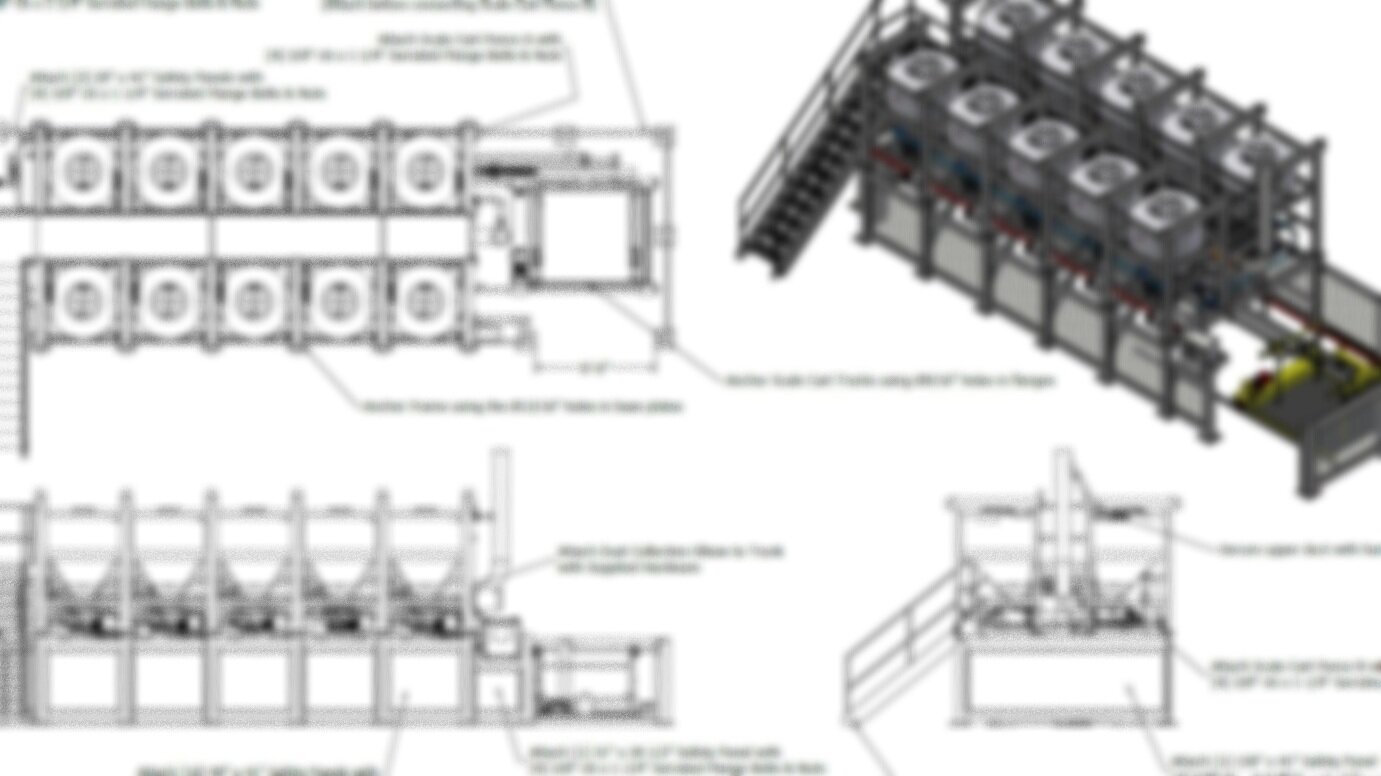
Case Study:
Insight Beverages
Automated System Enhances Ingredient Batching Process
A powdered beverage producer installs an automated weighing and batching system to increase production and improve efficiency.
Insight Beverages Inc., Lake Zurich, Ill., produces a wide range of high-quality powdered beverage mixes for convenience stores, restaurants, and other customers. The powdered mixes make specialty coffees, hot chocolates, smoothies, and many other beverages. When the company first began operations in 1981, operators would place a barrel on a weighscale and hand-scoop a product’s ingredients into it, individually weighing each ingredient.
However, as demand for the products grew, the company found the manual batching process too time-consuming and labor-intensive. In 2009, after experiencing a sizable order upswing, the company decided to find a better way to batch the powdered ingredients.
Manually weighing ingredients causes problems
The company operates two shifts a day, 5 days a week. Customers can choose from more than 1,000 established recipes or work with the company’s R&D team to modify an existing recipe or create a new one. The ingredients, which range from very fine powders to granules, are used in quantities of a few grams to more than 10 pounds each.
In the past, to make a product an operator printed out the product’s recipe and moved the required ingredients to the batching room. After scooping the proper ingredient amount into a plastic-lined 50-pound barrel, the operator moved the barrel to the mixing area, where the ingredients were blended, then packaged and shipped to the customer.
Manually weighing the ingredients was not only slow, but created potential quality control issues, such as cross-contamination. “We work with allergens such as egg, wheat, soy, and dairy powders, and we make certain products according to kosher and halal guidelines, so we’ re very focused on preventing cross-contamination, which was difficult when operators had to handle the ingredients,” says Gary Berg, Insight Beverages plant manager. “Also, having to thoroughly clean everything between products slowed the batching process. The plastic-lined batch barrels move through the weighing and batching system like a train, stopping at each batching zone’s weigh station to collect material from the appropriate ingredient dispensers.  Plus, manual weighing meant that there was always the chance of putting too much or too little of an ingredient in a barrel.”
From years of experience working in the food industry, Berg knew that one of the most effective ways to reduce these and other risks is to minimize the manual labor. “We needed an automated weighing and batching system that would improve the operation’s batching efficiency, prevent cross-contamination, and consistently perform close-tolerance batching of multiple ingredients with a range of characteristics,” says Berg. “The new system also had to integrate with our plant-wide computer system, be easy for our operators to use, and have an ROI of two to three years.”
Seeing a solution in action
Berg contacted people he had worked with at another food company about possible solutions. He also talked with several equipment suppliers and manufacturers’ reps about their equipment’s strengths and features and their familiarity with powdered food ingredient processing. One supplier’s automated gain-in-weight weighing and batching system stood out, so he and the supplier’s rep traveled to a nearby food processer’s plant to witness it in operation.
“The weighing and batching system had many of the features we wanted, such as the ability to simultaneously process multiple recipes, and it had been operating for years with virtually no issues,” says Berg. “Seeing the gain-in-weight system in action gave us some good operational information and helped us see how we could position a similar system in our work area to best operate and service it.
“The supplier provides food-grade polyethylene hoppers rather than more expensive stainless steel hoppers, which made the system’s initial cost lower than the others we looked at. We also found the supplier’s custom programming for the automation to be more advanced and better suited to our operation. We decided to buy a similar system.”
The supplier, Ingredient Masters, Cincinnati, designs and manufactures automated batching systems, pneumatic conveying systems, and other bulk handling equipment for the food, pharmaceutical, chemical, and other industries.
The weighing and batching system
In early 2010, the supplier installed the custom-designed automated gainin-weight weighing and batching system in the company’s batching room. The system consists of 20 removable 28-cubic-foot ingredient dispensers, 20 screw feeders with helix screws, one powered infeed roller conveyor, five scaling roller conveyors, one powered outfeed conveyor with a checkweigh station, and one PLC controller that controls the entire system’s operation.
A custom-engineered structural steel frame with a top-access walkway supports the system’s components and allows operators easy access to the dispensers for refilling them. It also creates two 10-dispenser parallel rows with about 50 inches of space between them. The powered infeed and outfeed conveyors along with the five scaling conveyors form a straight line between the two dispenser rows. This results in five batching zones that receive product from the four adjacent ingredient dispensers (two from each row). The conveyor moves the batch barrels along the line, stopping at each batching zone’s weigh station to collect material from the appropriate ingredient dispensers in each batching zone.
The polyethylene ingredient dispensers are approved for use in USDA, FDA, and 3-A Dairy applications. Dispensers that hold a sticky, non-free-flowing ingredient use air pads and vibrators to aid material discharge. A dust collection port connected to the company’s dust control system is inside each dispenser and removes dust generated during refilling.
At each weigh station, a screw feeder bulk-and-dribble-feeds the ingredient into a batch barrel. The company sets the maximum feedrate for each dispenser according to the ingredient it contains. A computer-controlled cutoff valve on the end of each screw feeder closes when the feeder stops, preventing material from the screw flight from falling into the barrel. Additionally, a dust collection port mounted above each weigh station near the screw feeders’ discharge collects any dust generated during feeding.
The system’s PLC controller has a flat-panel touchscreen that allows an operator to easily call up the various recipes, monitor the system’s components and operation, and manage inventory. For quality control, if an ingredient runs low during operation or an ingredient being filled into a batch barrel falls outside the system’s ±0.5-percent accuracy range, the PLC sounds an alarm and stops the system until an operator acknowledges it. The PLC also generates a tag that gives the lot number of each individual ingredient used in a recipe, allowing the company to track lot numbers from the ingredient manufacturer all the way into the finished product to provide complete quality control. The PLC is connected to the company’s plant-wide computer system, allowing remote monitoring of the batching process, automatic inventory control, and recipes to be downloaded directly from a central location rather than input manually at the PLC.
Automating the weighing and batching process
To batch a beverage product using the new system, an operator loads empty batch barrels onto the infeed conveyor, then accesses the PLC and calls up one or more recipes. For each recipe, the operator inputs the batch size, and the PLC calculates the percentages and weights for each ingredient. Next, the operator pushes the start button, and the infeed conveyor moves an empty barrel to the first scaling conveyor, which moves the barrel to the first weigh station. Once the barrel is in position, the PLC activates the screw feeders one at a time to feed the required ingredients into the barrel.
After the first weigh station’s ingredients have filled into the barrel, the conveyor moves the barrel to the next scaling conveyor, which moves it to the next weigh station. At the same time, the PLC calls up the second recipe in the queue (which may be the same as the first or a different one), and a second barrel moves into the system and is positioned at the first weigh station. When both barrels have been filled, the conveyors advance each barrel to the next weigh station, and the process continues for each recipe in the queue, with the barrels advancing through the system like a train, stopping at each weigh station to receive the required ingredients.
After a barrel exits the system onto the outfeed conveyor, it’s positioned on the checkweigh station so the PLC and operator can verify the total batch weight. The operator then covers the barrel, attaches a printed lot tag, and puts the barrel on a pallet that’s moved to the mixing area. The system, which is programmed so that a barrel can receive ingredients from one to 20 dispensers, can complete a batch containing five ingredients in about 6 minutes, depending on each ingredient amount.
Improving ingredient batching
Since installing the automated weighing and batching system, the company’s batching process has significantly improved. “We’ve cut the batching time in half and decreased the number of operators required,” says Berg. “The system was easy to learn how to use and has been working really well. The fast batch times are a definite improvement over hand-weighing the ingredients, and the removable dispensers are easy to clean if we want to switch ingredients; we simply lift the dispensers out of the frame and move them into the cleaning room.”
According to Berg, “Automating the process minimized cross-contamination by reducing manual labor involved in the batching process, and connecting the system to the dust collector simplified housekeeping and eliminated product waste. The system greatly improved the quality control of our products and will help us achieve Safe Quality Food certification. We’re even on target to see a three-year ROI.”
As seen in Powder and Bulk Engineering, September 2011.

